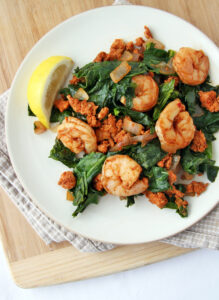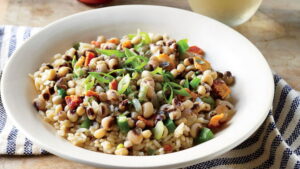Good Luck With New Year’s Meals!
go.ncsu.edu/readext?979576
en Español / em Português
El inglés es el idioma de control de esta página. En la medida en que haya algún conflicto entre la traducción al inglés y la traducción, el inglés prevalece.
Al hacer clic en el enlace de traducción se activa un servicio de traducción gratuito para convertir la página al español. Al igual que con cualquier traducción por Internet, la conversión no es sensible al contexto y puede que no traduzca el texto en su significado original. NC State Extension no garantiza la exactitud del texto traducido. Por favor, tenga en cuenta que algunas aplicaciones y/o servicios pueden no funcionar como se espera cuando se traducen.
Português
Inglês é o idioma de controle desta página. Na medida que haja algum conflito entre o texto original em Inglês e a tradução, o Inglês prevalece.
Ao clicar no link de tradução, um serviço gratuito de tradução será ativado para converter a página para o Português. Como em qualquer tradução pela internet, a conversão não é sensivel ao contexto e pode não ocorrer a tradução para o significado orginal. O serviço de Extensão da Carolina do Norte (NC State Extension) não garante a exatidão do texto traduzido. Por favor, observe que algumas funções ou serviços podem não funcionar como esperado após a tradução.
English
English is the controlling language of this page. To the extent there is any conflict between the English text and the translation, English controls.
Clicking on the translation link activates a free translation service to convert the page to Spanish. As with any Internet translation, the conversion is not context-sensitive and may not translate the text to its original meaning. NC State Extension does not guarantee the accuracy of the translated text. Please note that some applications and/or services may not function as expected when translated.
Collapse ▲As New Year’s Day approaches, people around the world plan for the coming year, eager to get off to the best possible start. Many people will “eat for good luck” with special foods, which are traditionally thought to bring good fortune in the new year.
Many nationalities consider eating ham or pork on New Year’s Day to be good luck. Why pork? Europeans hunted for wild boars in forests hundreds of years ago and killed them on the first day of the year. Pigs were also associated with plumpness and getting plenty to eat. This tradition came to the United States when people settled in different regions, especially the Carolinas.
African Americans in the Carolinas during the eighteenth and nineteenth centuries made one of the most enduring contributions to modern holiday traditions. Hoppin’ John and greens became traditional New Year’s fare, with black-eyed peas thought to bring luck, and rice (which swelled during cooking) and greens (like money) bringing prosperity.
Of course, collard greens would be a good choice to add to a meal on any day of the year! A half-cup of boiled, drained collards have just 25 calories but offer 130 milligrams of calcium. They’re also chock-full of phytonutrients for which your body will thank you. The bottom line? Start out the New Year right — not necessarily with any particular dish, but by eating balanced meals, plenty of fruits and vegetables, and following the age-old tradition of “everything in moderation.”
If you would like to learn more about the Mediterranean healthy lifestyle including cooking and eating patterns, I encourage you to call the Beaufort County Center of N.C. Cooperative Extension at 252-946-0111 for information on how to join the 6 cooking classes offered January 25 – February 29 evenings from 5:30-8:30 p.m.
If you want to keep the New Year’s food tradition while staying in line with the Mediterranean Diet, try this recipe:
Shrimp and Collard Greens Stir Fry

Shrimp & Collard Greens Stir Fry
- 1 1/2 lb. of frozen shrimp (shelled), thawed
- 1lb. collard greens
- 1 tbsp canola oil
- 1 clove garlic, finely minced
- 1/2 tsp. grated fresh ginger
- 1 1/2 tbsp. water
- 1/8 tsp. salt
- 1 tsp. sesame oil
- 4 cups cooked brown rice
Directions:
- Trim the ends off the stems of the greens and separate the leaves. Clean under running water and drain.
- Cut stems into 1-inch pieces, and cut the leaves into wide ribbons. Finely mince garlic and grate fresh ginger.
- Add canola oil, sesame oil, and ginger to a cold pan and heat on medium-high heat.
- When the herbs become fragrant and just begin to turn brown, add the stems of collards. One minute later add the collard leaves and shrimp.
- Toss well to coat with the oil, and cook until stems become tender and the shrimp turns pink, about 3 minutes.
- Serve warm.
Black-eyed Peas are another Southern traditional food for the New Year’s. The following is a classic recipe to celebrate our Southern Heritage!
Classic Hoppin’ John (or small changes to follow the Med Way)

Classic Hoppin John
- 2 thick-cut bacon slices, chopped (or skip the bacon and add 3 T. extra virgin olive oil)
- 4 celery stalks, sliced (about 1 1/2 cups)
- 1 medium-size yellow onion, chopped (about 1 1/2 cups)
- 1 small green bell pepper, finely chopped (about 1 cup)
- 3 garlic cloves, chopped ( about 1 Tbsp.)
- 1 tsp. chopped fresh thyme
- 1/2 tsp. black pepper
- 1/4 tsp. cayenne pepper
- 1 1/2 tsp. salt, divided
- 8 cups lower-sodium chicken broth
- 4 cups of frozen black-eyed peas
- 2 Tbsp. olive oil
- 1 1/2 cups uncooked white rice (or just before serving stir in 3 cups of cooked brown rice, heat until hot)
- Garnish with fresh scallions, sliced
Directions:
- Cook bacon in a Dutch oven over medium-high, stirring occasionally, until starting to crisp, about 10 minutes
- Add celery onion, bell pepper, garlic, thyme, black pepper, cayenne, and 1 teaspoon of the salt. Cook, stirring occasionally, until onion is tender, about 8 minutes.
- Add broth and black-eyed peas, and bring to a boil over medium-high. Reduce heat to medium-low, and simmer until peas are tender, about 40 minutes.
- Drain pea mixture, (reserving liquid to cook rice below). Return pea mixture and 1 cup of the cooking liquid to Dutch oven. Cover to keep warm; set aside.
- Heat oil in a medium saucepan over medium-high. Add rice and cook, stirring often, until fragrant and lightly toasted, 3 to 4 minutes. Stir in 3 cups of the reserved cooking liquid and remaining 1/2 teaspoon salt. Bring to a boil, and reduce heat to medium-low; cover and cook until rice is tender, 15 to 18 minutes. Fluff rice with a fork.
- Gently stir into pea mixture in Dutch oven. Stir in remaining cooking liquid, 1/4 cup at a time, until desired consistency is reached. Garnish each servings with sliced fresh scallions.
Sources for this article NC Extension Food and Nutrition, Meds instead of Meds educational program. For more information about the Foods and Nutrition please contact Louise L. Hinsley, Extension Agent, Family Consumer Science at the Beaufort County Center of N.C. Cooperative Extension, 155 Airport Road, Washington, 252-946-0111



